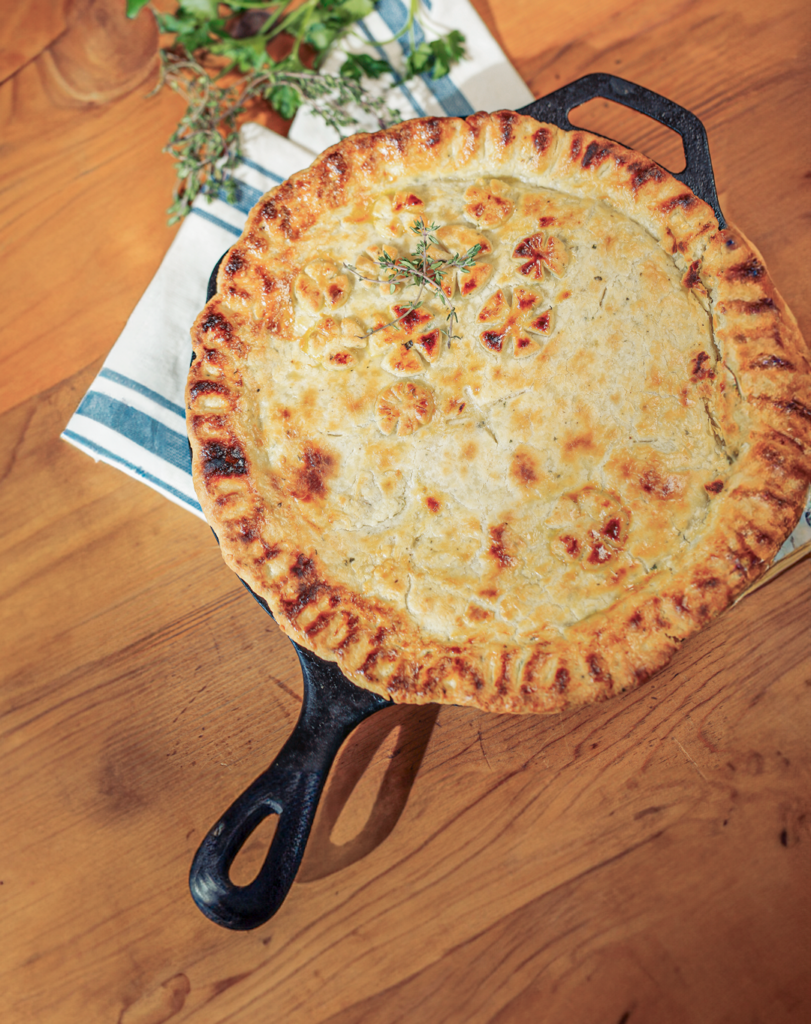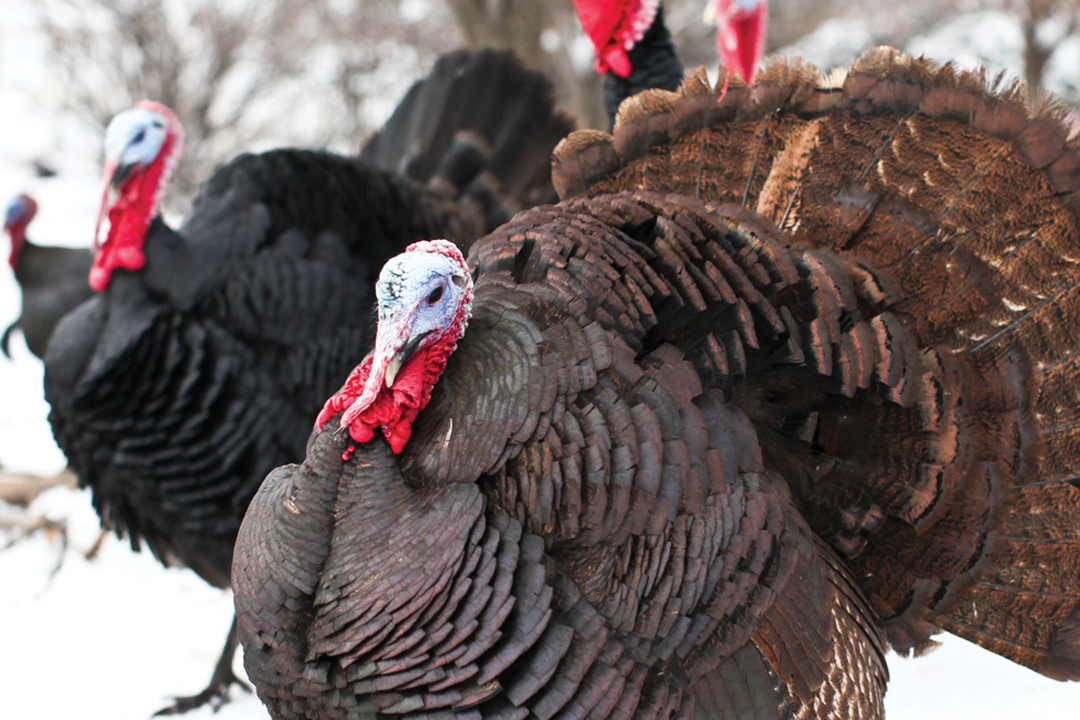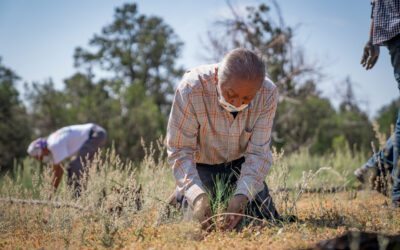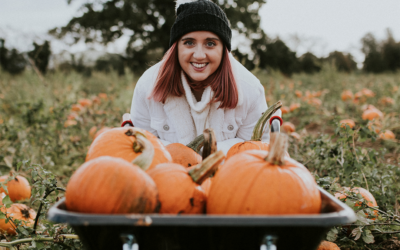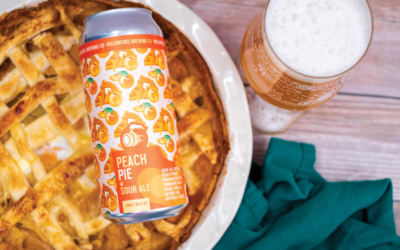Most of us have no clue about the journey our Thanksgiving Day turkey took to end up on our dinner table.
Kristin Ramey and Aaron Rice know all too well what it took to bring that turkey up from a hatchling, and they think it’s important for the rest of us to know too.
Ramey is the owner of Long Shadow Farm in Berthoud, where she and her family have raised chickens, sheep, pigs, ducks, “a few cows” and, of course, turkeys, since 2007. Rice is the owner of Jodar Farms in Fort Collins, where he has also raised chickens, pigs and turkeys for the last 15 years.
One year, Ramey says her family raised a record 273 turkeys from hatch to up to 24 weeks, when they were ready for slaughter. Now they raise more like 80 or 90 turkeys per year. Rice says Jodar Farms used to raise up to 400 turkeys a year, but they now focus on about 150. No matter how you slice it, these are smaller operations.
Ever since Longmont’s turkey processing plant, Butterball, closed in 2011, many of Colorado’s larger turkey operations have also gone away. As a result, Ramey, Rice and a few other farms across the state have maintained smaller footprints so they can process their own meat.
Both farms produce pasture-raised turkeys, but the two go about it in a much different way.

Larry and Ramey of Long Shadow Farm with their daughter Shannon and Great Pyrenees Odin. Photo by Elise Taylor.
Long Shadow Farm
Ramey, her husband, Larry, and their daughter, Shannon, 14, run a family-oriented farm. Shannon gives many of the turkeys names during the growing season. “There’s always a Big Tom,” Ramey says. “But she is getting more creative. We have one called Lavender this season.”
There are two main types of turkeys: broad breasted white and heritage or wild. Broad breasted turkeys are what most of us see on the table at Thanksgiving dinner. The bird has been bred over the years to have more meat on the sternum. “They have a lot more white meat,” Ramey says.
While Ramey usually buys a couple broad breasted chicks from her daughter’s 4-H Club every year to raise, the majority of her gaggle or rafter (both acceptable terms for a group of turkeys) are heritage, which look more like their wild turkey counterparts. In fact, a wild turkey once joined in with her other birds after a particularly violent windstorm. “He just moved right in,” she says.
Long Shadow turkeys are kept in a coop when they are babies to protect them from owls, coyotes and other predators. The rest of the time, they are free as, well, a bird.
“My guys are never truly confined,” Ramey says. “They aren’t trained to go in a coop. They actually like to sleep in the pine trees.”
Yes, apparently heritage turkeys can fly a little. “They can easily jump the fences and go anywhere. My neighbors see them all the time. But they know where the food and water is, so they don’t go far,” she says.
Ramey’s turkeys eat the grasses in the area and have a high-protein diet. “Let’s just say you won’t see any grasshoppers around my farm,” she says.
Broad breasted birds can grow up to 20-30 pounds—any bigger and they are hard to cook—over the course of 16 weeks. Heritage hens (females) reach 6-12 pounds over a 24-week growing season, and the toms (males) grow to 12-18 pounds in that time.
At the end of the growing season, Ramey and her daughter select three toms and about 40 hens to breed for the following year. “The ratio has to be right. If you get too many toms, the guys spend all their time showing off and being macho and not doing what they are supposed to be doing,” she says.
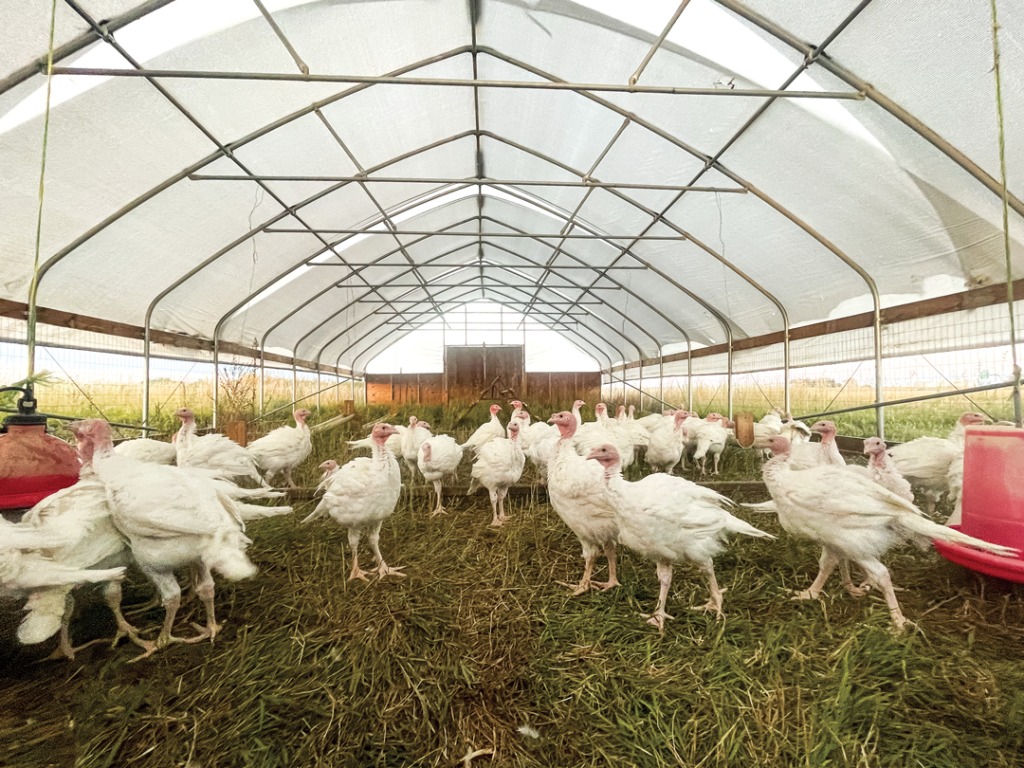
Jodar Farms turkeys roaming their coop.
Jodar Farms
Rice’s turkeys are all broad breasted. “Heritage ones don’t dress out the way most people are used to,” he says.
Jodar Farms gets their turkeys at just 2-3 days old from a hatchery in South Carolina. During their early days, they are kept in an insulated semi-truck, called a brooder, until their feathers come out.
Those first few weeks are precarious, Rice says. Babies can even freeze in their drinking water without a mom to rescue them.
“They work really hard to find ways to kill themselves,” he says. “After that, they are pretty hardy birds.”
After a few weeks, when the turkeys are big enough, Rice transfers them to portable pasture coops with an open floor to let them explore the grass and eat. He moves the coop around the pasture every few days so they can get new food. This also spreads their manure evenly to help the grass grow.
The birds at Jodar Farms are mostly kept in coops, but it’s for their own protection. Rice says owls, skunks, foxes and coyotes are always looking to snatch up a turkey.
“We actually had an owl scratch through the plastic coop to try to get one,” he says.
The end of the turkey season is a week or so before Thanksgiving. Jodar, like Long Shadow, does their own processing (the nice way of saying slaughter). While Long Shadow sells their turkeys for $5 per pound, Jodar’s birds go for $6.75 per pound.
Rice says birds from a smaller farm are far superior to ones from a large-scale operation: “When you taste the difference, it’s like night and day. You just get a better flavor and texture than commercial birds.”
A harvest of effort
Both farms always sell out of their birds before the holiday by way of reservations. They usually have a waiting list for the next year.
However, they each save a turkey for their own families.
“Of course we eat turkey on Thanksgiving,” Rice says. “After all that hard work, we earned it.”
At Long Shadow, the end of the turkey season also signals the coming of winter. Turkeys are the last of the work to be done.
“It’s kind of sad,” Ramey says. “But it’s a time to look back at all we did and get ready to do it all again next year.”
Creative Ways to Enjoy Your Thanksgiving Bird
If you’re looking for a special dish to serve at Friendsgiving—or a new way to savor your leftovers—try one of these delicious turkey recipes from a few of our favorite local restaurants.
Pilgrim Sandwich
From Yampa Sandwich Co.
The Pilgrim has freshly sliced turkey breast, house-made seasoned stuffing, Yampa’s signature cranberry chutney, mayonnaise, gouda cheese and lettuce. According to Chief Brand Officer Dave Pepin, the cranberry chutney is founder Peter Boniface’s mother’s recipe, and it’s available for purchase by the jar at any Yampa location. The entire sandwich is toasted and served warm.
Pepin says the Pilgrim was one of the original sandwiches on the Yampa menu and is still a top seller 23 years later. It’s available all year round.

Autumn Turkey Salad Sandwich
From CooperSmith’s Pub & Brewing
INGREDIENTS:
2 1/2cups diced turkey breast (preferably roasted)
3/4 cup diced celery
3/4 cup diced yellow onions
1 1/2 cups chopped pecans
1 1/2 cups dried cherries
Sauce:
1/2 cup mayo
2 teaspoons brown sugar dissolved in 1 teaspoon apple cider vinegar
1/4 teaspoon cinnamon
1/8 teaspoon nutmeg
1/2 teaspoon salt
1/4 teaspoon black pepper
METHOD:
Mix the celery, onions, pecans, dried cherries and turkey together. Make the sauce with the rest of the ingredients and fold into the turkey mixture. Serve on toasted grain bread with lettuce and tomato.
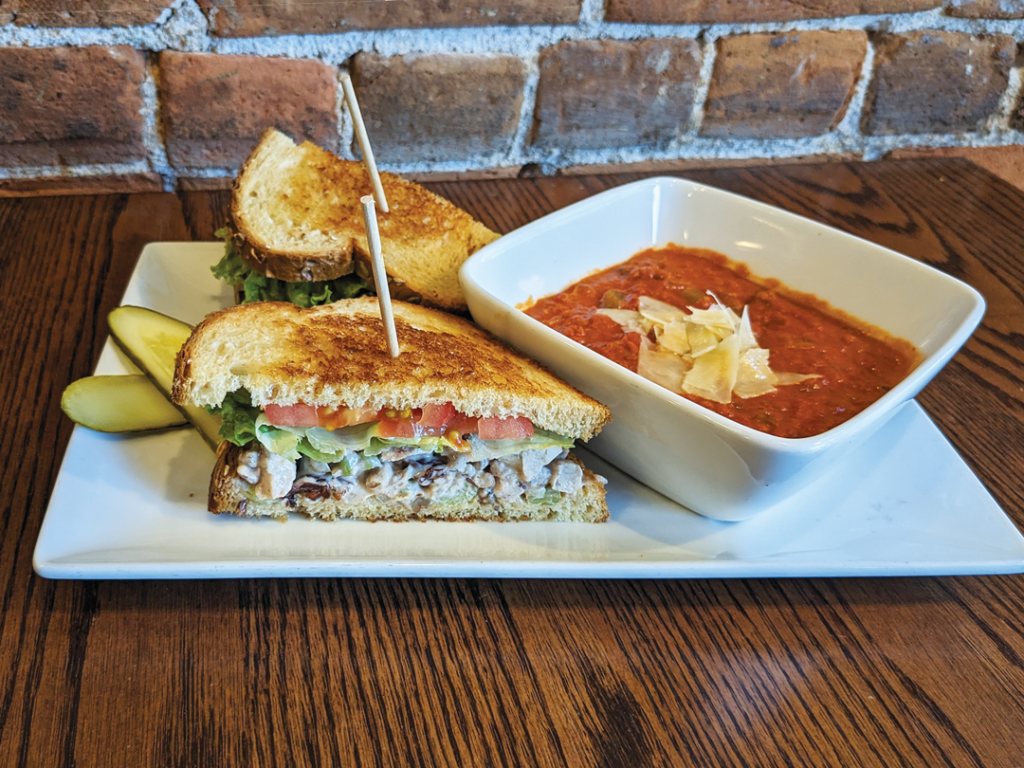
Turkey and Butternut Squash Pot Pie
From Ginger and Baker – Yield: 6-8 servings
Ingredients:
Dough to make two pie crusts*
4 tablespoons oil of choice
1 medium onion, diced
2 stalks celery, sliced
1 ½ cups cooked and diced butternut squash
2 cloves garlic, minced
3 cups (24 ounces) chicken stock, heated
3 tablespoons butter, softened
1/4 cup flour
2 cups heavy cream
4 cups cooked turkey, diced into
1-inch chunks (white and dark meat)
1 cup fresh or frozen spring peas
2 tablespoons chopped fresh sage
2 tablespoons chopped fresh parsley
1 tablespoon chopped fresh tarragon
2 teaspoons dried summer savory
1 teaspoon nutmeg
1 teaspoon black pepper
2-3 teaspoons salt
Egg wash: 1 egg, 2 tablespoons heavy cream and a pinch of salt
Method:
1. Heat oil in a large skillet over medium heat. Add onion, celery and butternut squash and cook until onions are slightly translucent. Add garlic and cook for another minute. Add 1 cup chicken stock, bring to a simmer and reduce by half, about 5 minutes.
2. In a small bowl, combine softened butter with flour, stirring until it forms a little dough ball. Add to vegetable mixture and whisk it until butter and flour melt into the liquid. Add cream and stir again; mixture will be very thick.
3. Stir a cup of hot stock into the vegetable/cream mixture. Simmer for an additional 5-7 minutes, until sauce begins to thicken. Add remaining 1 cup stock.
4. Remove from heat and add chopped turkey, peas and fresh and dried herbs. Season with salt and pepper. Let the filling cool before filling crust.
5. To assemble the pie: Preheat the oven to 350°F. Spray an 8- or 9-inch cast iron skillet with cooking spray.
6. On a lightly floured surface, roll out the bottom crust to roughly 3 inches larger than your baking dish. Transfer dough to dish and leave the extra hanging over the sides.
7. Roll out top crust to be about 2 inches larger than your dish.
8. Using a slotted spoon, transfer your cooled turkey mixture to the bottom crust. Fill to just slightly over the rim line (make sure any liquid does not go higher than 1 inch from the pie rim). Brush the edges of the crust with egg wash.
9. Place the remaining crust on top, slightly pressing to seal. Fold the edges of the bottom crust over the top crust then crimp.
10. Brush egg wash generously over the top, making sure to get all the crimps and crevices.
11. Place pie on a baking sheet and bake until crust is golden brown, about
45-60 minutes. Let cool for 15 minutes before serving.
*Use 1 package refrigerated pie crusts, or visit the blog at gingerandbaker.com for a homemade pie crust recipe.
